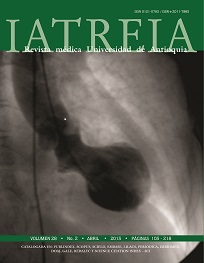Estudio y manejo clínico de menores que conviven con pacientes de tuberculosis pulmonar, Medellín 2010-2011
DOI:
https://doi.org/10.17533/udea.iatreia.v28n2a04Palabras clave:
isoniazida, preescolar, tuberculosis, tuberculosis latenteResumen
Introducción: el tratamiento para tuberculosis latente disminuye el riesgo de infección de los niños que conviven con pacientes de dicha enfermedad.
Objetivo: describir el estudio y manejo clínico de los menores de 5 años que convivían en Medellín con pacientes de tuberculosis pulmonar en el período 2010-2011.
Materiales y métodos: estudio observacional de corte. Se exploró la relación entre las características sociodemográficas, clínicas y de manejo de los niños y los casos índice.
Resultados: 28,6% fueron estudiados al menos con radiografía de tórax y prueba de tuberculina. De los evaluados clínicamente, 7,9% tenían tuberculosis activa; de los demás, 19,4% recibieron tratamiento para tuberculosis latente. Hubo mayor oportunidad de ser estudiado si el conviviente tenía régimen de salud contributivo o subsidiado (OR ajustado: 6,7; IC 95%:1,5-30,5). La oportunidad de recibir tratamiento para tuberculosis latente se relacionó con la prueba de tuberculina (OR ajustado: 40,2; IC 95%: 2,59-623,6).
Conclusión: los menores no estaban siendo adecuadamente estudiados ni recibían el tratamiento apropiado, por lo que su prevalencia de tuberculosis activa no disminuyó. Se requiere crear un protocolo estandarizado para el manejo de los menores en similares condiciones y supervisar su aplicación.
Descargas
Citas
(1.) Dye C, Floyd K. Tuberculosis. En: Jamison DT, Breman JG, Measham AR, Alleyne G, Claeson M, DB Evans, et al., editors. Disease Control Priorities in Developing Countries. 2° ed. Washington (DC): World Bank; 2006. p. 289-309.
(2.) World Health Organization. Stop TB Dept. Implementing the WHO Stop TB Strategy: a handbook for WHO; 2008. p. 46-59.
(3.) World Health Organization. Guidance for National Tuberculosis Programmes on the Management of Tuberculosis in Children. Geneva: WHO; 2006. p. 4-9, 16-19.
(4.) New Jersey Medical School National Tuberculosis Center. Management of Latent Tuberculosis Infection in Children and Adolescents: A Guide for the Primary Care Provider [Internet]. New Jersey: New Jersey Medical School; 2009. p. 6-11. Available from: http://www.umdnj.edu/globaltb/downloads/products/PediatricGuidelines%20%28Screen%29.pdf
(5.) Colombia. Ministerio de la Protección Social. Guía 11: Guía de Atención de la Tuberculosis Pulmonar y Extrapulmonar. En: Guías de promoción de la salud y prevención de enfermedades en la salud pública [Internet]. Bogotá: Scripto; 2007. p. 19-105. Disponible en: http://www.minsalud.gov.co/Documentos%20y%20Publicaciones/GUIAS%20DE%20ATENCION%20-TOMO%20DOS.pdf
(6.) Millard PS, Wilcosky TC, Reade-Christopher SJ, Weber DJ. Isoniazid-eelated fatal hepatitis. West J Med. 1996 Jun;164(6):486-91.
(7.) Centers for Disease Control and Prevention. Severe isoniazid-associated liver injuries among persons being treated for latent tuberculosis infection - United States, 2004-2008. MMWR Morb Mortal Wkly Rep. 2010 Mar;59(8):224-9.
(8.) Banu Rekha VV, Jagarajamma K, Wares F, Chandrasekaran V, Swaminathan S.Contact screening and chemoprophylaxis in India’s Revised Tuberculosis Control Programme: a situational analysis. Int J Tuberc Lung Dis. 2009 Dec;13(12):1507-12.
(9.) Van Wyk SS, Hamade H, Hesseling AC, Beyers N, Enarson DA, Mandalakas AM.Recording isoniazid preventive therapy delivery to children: operational challenges. Int J Tuberc Lung Dis. 2010 May;14(5):650-3.
(10.) del Corral H, París SC, Marín ND, Marín DM, López L, Henao HM, et al. IFNγ Response to Mycobacterium tuberculosis, Risk of Infection and Disease in Household Contacts of Tuberculosis Patients in Colombia. PLoS One [Internet]. 2009 Dec;4(12):e8257. Available from: http://www.plosone.org/article/info%3Adoi%2F10.1371%2Fjournal.pone.0008257
(11.) Claessens NJ, Gausi FF, Meijnen S, Weismuller MM, Salaniponi FM, Harries AD. Screening childhood contacts of patients with smear-positive pulmonary tuberculosis in Malawi. Int J Tuberc Lung Dis. 2002 Apr;6(4):362-4.
(12.) van Wyk SS, Reid AJ, Mandalakas AM, Enarson DA, Beyers N, Morrison J, et al. Operational challenges in managing Isoniazid Preventive Therapy in child contacts: a high-burden setting perspective. BMC Public Health. 2011 Jul;11:544.
(13.) Cuervo J. Características, resultados del tratamiento antituberculoso y factores determinantes de abandono en casos nuevos tratados en las instituciones de salud que notifican al programa de prevención y control de tuberculosis de la Secretaría Distrital de Salud de Santafé de Bogotá durante 1999. [Tesis Ma-gíster en epidemiología clínica]. Bogotá: Pontificia Universidad Javeriana. Facultad de Medicina; 2001.
(14.) Colombia. Ministerio de la Protección Social. Tomo V: Prestación de Servicios de Salud. En: Análisis de la Situación de Salud en Colombia, 2002-2007 [In-ternet]. Bogotá: Imprenta Nacional de Colombia; 2010. Disponible en: http://www.minsalud.gov.co/Documentos%20y%20 Publicaciones/ASIS-Tomo%20V--Prestaci%C3%B3n%20de%20servicios%20de%20sa-lud.pdf
(15.) Arbeláez MP. La reforma del sector salud y el control de la tuberculosis en Colombia. En: Yadón ZE, Gürt-ler RE, Tobar F, AC Medici, editores. Descentralización y gestión del control de las enfermedades transmisibles en América Latina. Buenos Aires: OPS. 2006. p. 115–29.
(16.) Hernández M. Reforma sanitaria, equidad y derecho a la salud en Colombia. Cad Saúde Pública. 2002 Jul-Ago;18(4):991–1001.
(17.) Quintana S. El acceso a los servicios de salud en Colombia 2002 [Internet]. España: Médicos Sin Fronteras; 2002. [consultado 2012 feb 3]. Disponible en: http://www.disaster-info.net/desplazados/informes/msf/accesosaludcol.htm
(18.) Marais BJ, van Zyl S, Schaaf HS, van Aardt M, Gie RP, Beyers N. Adherence to isoniazid preventive chemotherapy: a prospective community based study. Arch Dis Child. 2006 Sep;91(9):762-5.
(19.) van Zyl S, Marais BJ, Hesseling AC, Gie RP, Beyers N, Schaaf HS. Adherence to anti-tuberculosis chemoprophylaxis and treatment in children. Int J Tuberc Lung Dis. 2006 Jan;10(1):13-8.
(20.) Véjar Mourgués L, Henao R M. Adherencia a quimio-profilaxis de niños chilenos expuestos a tuberculosis del adulto. Rev Chil Enferm Respir. 2006;22(3):164-7.
Descargas
Publicado
Cómo citar
Número
Sección
Licencia
Derechos de autor 2015 Iatreia

Esta obra está bajo una licencia internacional Creative Commons Atribución-CompartirIgual 4.0.
Los artículos publicados en la revista están disponibles para ser utilizados bajo la licencia Creative Commons, específicamente son de Reconocimiento-NoComercial-CompartirIgual 4.0 Internacional.
Los trabajos enviados deben ser inéditos y suministrados exclusivamente a la Revista; se exige al autor que envía sus contribuciones presentar los formatos: presentación de artículo y responsabilidad de autoría completamente diligenciados.














